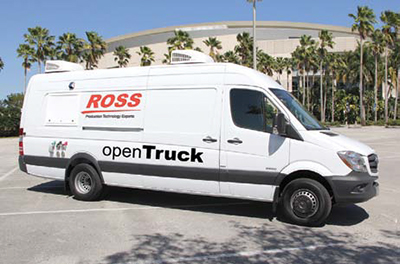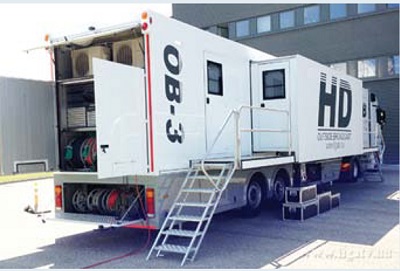New Generation of Sports Trucks Hits the Road

Game Creek recently deployed its “Amazin” 53-foot expand truck for the SNY cable sports network.SEATTLE—This is a big year in the sports remote truck business. The video, audio, routing, storage and other such technology used to build remote trucks may advance every couple of years or so, but according to George Hoover, chief technology officer for NEP Supershooters in Pittsburgh, the technological upheaval in these trucks is on a longer timeline. And 2014 is the trigger to reset that timeline because of new NFL rights agreements with the networks.
This year marks the start of their eight-to-10 year deal with the NFL, “so everybody has built or is building new trucks or upgrading [existing trucks] to support the networks, and that’s the key financial driver of technology upheaval,” Hoover said, adding that a lot has changed in the past eight years.
“The biggest thing that has changed is that the previous generation of NFL trucks was built for the 2006 season start,” he said. “That was really second-generation HD equipment. We’re now moving into third and fourth generation HD equipment, and so there are bigger, more powerful HD production switchers, very elaborate embedded audio, infrastructure, the latest in servers, the latest audio consoles. Essentially, all of the key components have upgraded a generation or two since the last NFL rights package happened.”
One of those components is monitor walls. “Back in 2006 the jury was still out— in half the trucks we built in 2006, the production team still wanted to have glass monitors, and then there were the groups who were perhaps forward-thinking, who went with virtual, multi-viewer types displays.” Hoover said that today everyone wants “a virtual monitor wall which affords you much more flexibility and much more recallability.”
F&F Productions recently launched its GTX17 sports production truck, which was used by CBS Sports and ESPN to cover the 2014 US open tennis championship. THE ROLE OF 4K
Even with all the new and upgraded trucks joining the fleet to service new network contracts, Marc Orgera, vice president of sales and marketing for F&F Productions in Clearwater, Fla., said his company is taking a cautious approach. “We just put our GTX 17 on the road this summer, but if we didn’t have a contract we wouldn’t build a truck right now,” Orgera said. “We’re right on the cusp of the next level of truck, with technology changing, and in three years—maybe even sooner—we see 4K cameras out there.”

4K is already in use on remote trucks as specialty cameras provide the ability to zoom into replays without dipping beneath HD resolution. But if you wanted to replicate a first-class remote truck in 4K today, Orgera said all the pieces aren’t yet in place.
“If you want to do 4K, right now you’re talking about a packet-based IP router,” he said. “But when you bring that to current switchers, you come up with a switcher that can’t pass it.” And though 4K cameras do exist, “the lenses aren’t there yet. You still have—I want to say they’re 25x or lower lenses—so you don’t have the powerful lenses [for the centerfield shot, as an example]. I’m not saying that they’re not going to be here in a few years, but they’re not here today.”
The professional video industry's #1 source for news, trends and product and tech information. Sign up below.
Orgera added that waiting on the final pieces of the technology puzzles is nothing new. “It’s just like HD was, it’s a revolution of equipment coming across.”
ROUTING ADVANCES
When SNY, cable network home to the New York Mets and New York Jets, tapped Game Creek Video, LLC to design and build its new mobile truck last year, both parties were excited about shortening setup and using the time saved for more ambitious pre-production for the telecasts.

Ross Video’s new truck division bases its vehicles on the Mercedes Sprinter platform. Sullivan pointed out that virtually every system on the SNY “Amazin’” truck has its own IP address, which can not only be addressed individually from the engineer’s chair, “but if we have issues with equipment on the truck we can allow access into the truck network by our vendors, and they can diagnose and do a workaround as well.”
“Starting back about 2002, the size and capability of routing systems were such that you really were able to make routercentral trucks,” said Pat Sullivan, owner and president of Game Creek in Hudson, N.H. “The setup for that was much faster than the traditional way of setting up a truck by using patch cords. And that whole thing has been refined over the past 10 or 12 years or so, so that the entire truck is now really controlled through networking as opposed to the traditional ways of patching and managing it that way.” Hours of plugging in patch cords has been replaced by the click of a mouse.
Grass Valley’s Truck Research Highlights Mobile Production Challenges
MONTREAL—A recently issued white paper from Grass Valley points out that though all production trucks benefit from the latest technology, such benefits largely skew to operators of average (5-10 cameras) and large (11 or more cameras) remote vehicles.
The study, “Production Truck Challenges,” found that more than 50 percent of respondents identified three technologies that most help in saving truck set-up time:
• Multiviewers displaying previous configurations
• From tape to digital storage
• Patchbay to “point and click” routing

One difference between small trucks and their larger siblings is that where larger remote vehicles have become router-centric, capable of a lot of flexibility in their configurations, many smaller production trucks are wired point-to-point. The smaller trucks never were hard to set up because there was relatively little to be reconfigured.
The study found that the ability of fiber to carry multiple channels of video and audio turns out to benefit only the large trucks, for the most part. These are the production trucks tasked to do large venue events, like golf and auto sports, which are rarely precabled and can involve installing miles and miles of cable. But small truck operators by a slight margin identified saying cable as a larger cause of delay than did average or large remote truck operators. This may have to do with small operators doing more of their remotes in venues that are not pre-cabled.
The white paper was written in collaboration with the Josh Gordon Group.
Craig Johnston
At stadiums away from home, the ability to recall and reload truck setup parameters from previous games is invaluable, according to Curt Gowdy, Jr., SNY vice president of production and executive producer. “On the first day when you’re at home, coming off a road trip, or when you’re on the road coming off a home stand, are always the most difficult because you’re in a new ballpark, especially when you’re on the road, and setup can be a little tricky based on certain things you’re working with, limitations around certain ballparks.”
ROSS OPENTRUCK
Ross Video is targeting the smaller remote truck market with its openTruck standard. To jumpstart its way into the business, the video production equipment vendor bought Plantation, Fla.-based mobile production company Mobile Content Providers a year ago, renaming it “Ross Mobile Productions.” The company now has five openTrucks providing production services.
“openTruck was designed around the need to get sports done cost-effectively,” said Jeff Moore, executive vice president and chief marketing officer at Ross Video in Iroquois, Ontario. “There’s an explosion going on now in coverage of high school and college level sports” that require a new generation of affordable mobile production vehicles equipped with the power and technology necessary to deliver high-definition content.
Moore said one key to the openTruck architecture is a tight integration between the Ross’ Carbonite production switcher and XPression graphics system. “This gives us the ability to replace literally five channels of a competitive product, and this cuts the cost down substantially,” he said.
Where Moore said other remote trucks vary greatly from unit to unit, keeping the openTruck fleet—housed in Mercedes Sprinters, largely the same configuration, truck to truck—accelerates setup because of crew familiarity. He also said openTruck makes use of being able to recall that entire truck’s settings the next time you want to set up for a similar event, which he terms “ the Holy Grail of truck operation.”
Other openTruck partners and their wares include Ikegami cameras, Canon lenses, Riedel intercoms, Abekas Mira servers and Soundcraft audio consoles.
